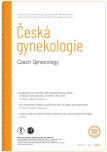Impact of residual defect of anal sphincter on patient’s quality of life
Authors:
Hubka Petr 1; Haddad El Rachid 2; Mašata Jaromír 3; Martan Alois 3; Švabík Kamil 3
Authors‘ workplace:
Gynekologicko-porodnická klinika 1. LF UK a FN Bulovka, Praha, ČR
1; Polyclinique de Blois, La Chaussée-Saint-Victor, Francie
2; Gynekologicko-porodnická klinika 1. LF UK a VFN v Praze, ČR
3
Published in:
Ceska Gynekol 2021; 86(3): 163-166
Category:
Original Article
doi:
https://doi.org/10.48095/cccg2021163
Overview
Aim: The aim of this retrospective study is to correlate the presence of residual anal sphincter defect with the quality of life of patients after vaginal delivery complicated with obstetrical anal sphincter injury.
Study group and methods: Patients diagnosed with obstetrical anal sphincter injury are dispensed at our urogynecological unit, with a mean follow-up period of 37 months. Two investigators blinded to the results of clinical symptoms evaluated archived ultrasound volumes taken for the presence of residual anal sphincter defects that were later correlated with the St. Mark’s Incontinence Score.
Results: The group comprises of 181 patients diagnosed with an obstetrical anal sphincter injury who underwent ultrasound examination of anal sphincter at three post-partum months. The questionnaires were completed by 118 patients (65.2% of all patients). A residual sphincter defect was diagnosed in seven cases (5.9%). In the group with residual defects, fecal urgency (lack of ability to defer defecation) was present in 57.1%. In the group without residual anal sphincter defects, fecal urgency was present in 12.6%. This difference is significant (< 0.001) with the contingency coefficient 0.291.
Conclusions: In conclusion, the presence of residual anal sphincter defect increases the probability of fecal urgency.
Keywords:
anal incontinence – obstetrical anal sphincter injury – ultrasound exam
Sources
1. Sultan AH, Thakar R. Lower genital tract and anal sphincter trauma. Best Pract Res Clin Obstet Gynaecol 2002; 16 (1): 99–115. doi: 10.1053/beog.2002.0258.
2. Sultan AH. Editorial: obstetrical perineal injury and anal incontinence. Clinical Risk 1999; 5 (6): 193–196. doi: 10.1177/135626229900500601.
3. Lincová M, Neumannová H, Mikysková I et al. Obstetric anal sphincter injuries – review of our date between 2015–2017. Ceska Gynekol 2019; 84 (1): 18–22.
4. Fernando RJ, Sultan AH, Kettle C et al. Methods of repair for obstetric anal sphincter injury. Cochrane Database Syst Rev 2013; 12: CD002866. doi: 10.1002/14651858.CD002866.pub3.
5. Masata J, Svabik K, Martan A. Ultrasound in urogynecology. Ceska Gynekol 2012; 77 (4): 292–298.
6. Hubka P, Svabik K, Masata J et al. Pilot study comparing tolerance of transperineal and endoanal ultrasound examination of anal sphincter. Ceska Gynekol 2019; 84 (2): 111–114.
7. Shek KL, Guzman-Rojas R, Dietz HP. Residual defects of the external anal sphincter following primary repair: an observational study using transperineal ultrasound. Ultrasound Obstet Gynecol 2014; 44 (6): 704–709. doi: 10.1002/uog.13368.
8. Speksnijder L, Oom DM, de Leeuw JW et al. Which factors are associated with anal incontinence after obstetric anal sphincter injury? Ultrasound Obstet Gynecol 2020. doi: 10.1002/uog.23525. Online ahead of print.
9. Subramaniam N, Dietz HP. What is a significant defect of the anal sphincter on translabial ultrasound? Ultrasound Obstet Gynecol 2020; 55 (3): 411–415. doi: 10.1002/uog. 20390.
10. Thomas GP, Gould LE, Casunuran F et al. A retrospective review of 1495 patients with obstetric anal sphincter injuries referred for assessment of function and endoanal ultrasonography. Int J Colorectal Dis 2017; 32 (9): 1321–1325. doi: 10.1007/s00384-017-2851-3.
11. Jorge JM, Wexner SD. Etiology and management of fecal incontinence. Dis Colon Rectum 1993; 36 (1): 77–97. doi: 10.1007/BF02050307.
12. Vaizey CJ, Carapeti E, Cahill JA et al. Prospective comparison of faecal incontinence grading systems. Gut 1999; 44 (1): 77–80. doi: 10.1136/gut.44.1.77.
13. Roos AM, Thakar MR, Sultan MA. Outcome of primary repair of obstetric anal sphincter injuries (OASIS): does the grade of tear matter? Ultrasound Obstet Gynecol 2010; 36 (3): 368–374. doi: 10.1002/uog.7512.
14. Abdool Z, Sultan AH, Thakar R. Ultrasound imaging of the anal sphincter complex: a review. Br J Radiol 2012; 85 (1015): 865–875. doi: 10.1259/bjr/27314678.
15. Volløyhaug I, Taithongchai A, Arendsen L et al. Is endoanal, introital or transperineal ultrasound diagnosis of sphincter defects more strongly associated with anal incontinence? Int Urogynecol J 2020; 31 (7): 1471–1478. doi: 10.1007/s00192-020-04274-9.
Labels
Paediatric gynaecology Gynaecology and obstetrics Reproduction medicineArticle was published in
Czech Gynaecology

2021 Issue 3
Most read in this issue
- Estetrol and the possibilities of its clinical use
- Adenomyosis – its possible effect on endometrial function and receptivity
- Hereditary antithrombin deficiency in pregnancy – severe thrombophilic disorder as a danger for mother and foetus
- Changes of the quality of sexual life following pelvic organ prolapse surgery
